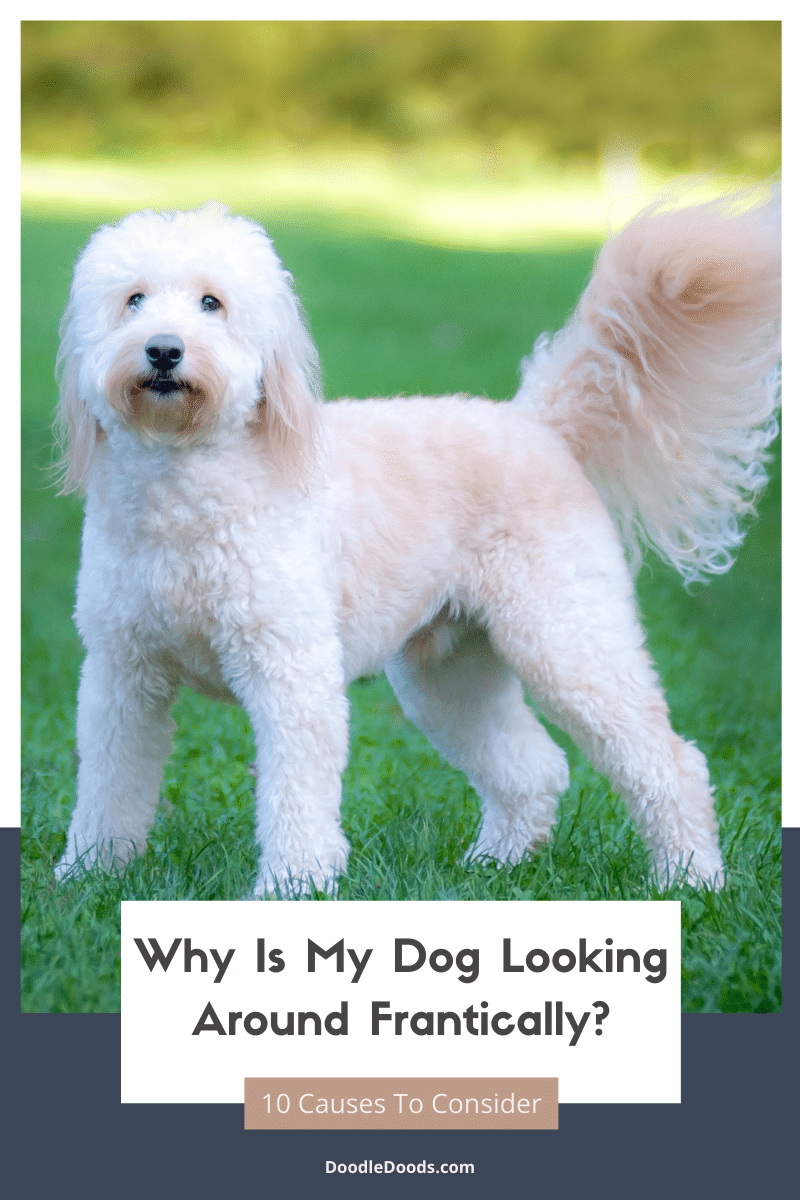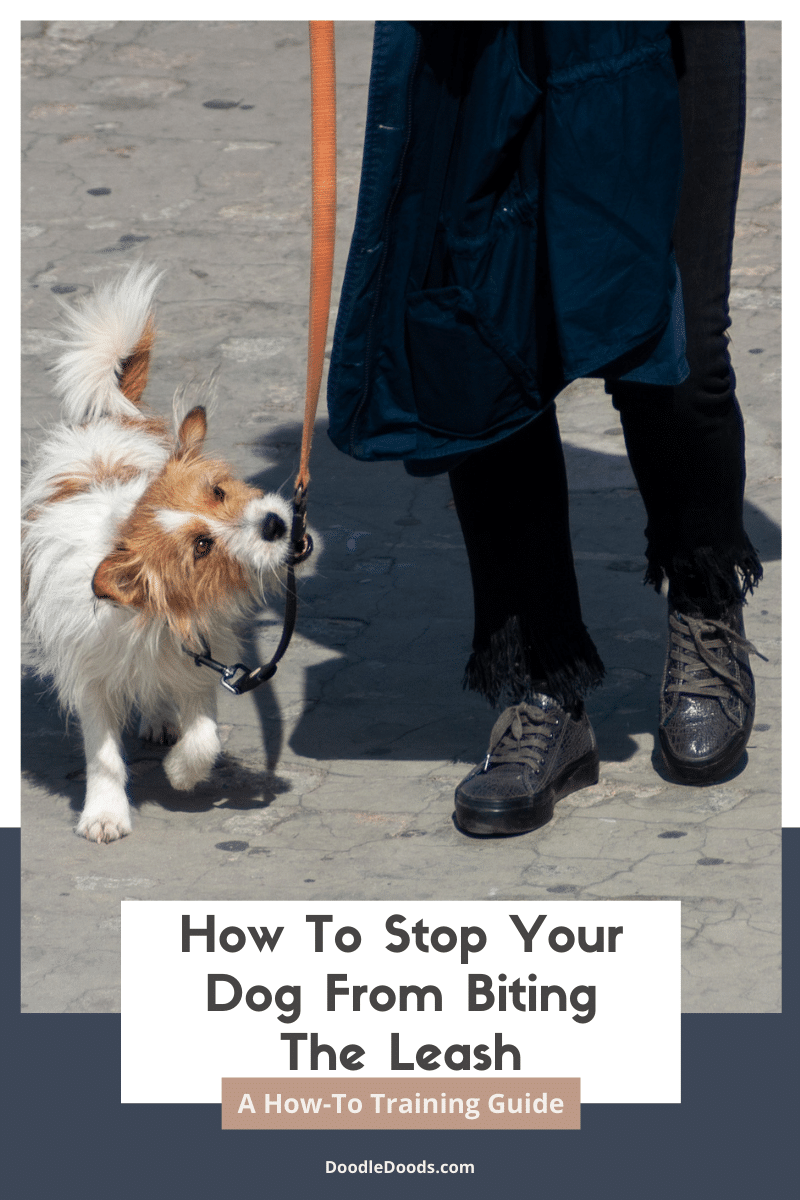Barking is not just part of your pet’s instinct; it serves as an important form of communication. So expecting your naturally chatty Doodle to give this behavior up altogether is unrealistic. That being said, there are few things more irritating than a dog who simply will not quit with its excessive barking.
If your darling little fur baby is sending you around the bend barking at every dog, cat, squirrel, and dust mote in sight, you’ll be relieved to hear that you don’t just have to buy a pair of high-quality earplugs and resign yourself (and your unfortunate neighbors) to your noisy fate.
So, how can you tackle the troublesome task of getting your beloved little rascal to pipe down a bit? Well, first, you’ll need to understand the reasons behind this bothersome behavior. In doing this, you can find the right methods to preserve both your sanity and your local reputation.
Table of Contents
- Why Does My Dog Bark?
- Ways To Stop Your Dog From Barking
- Frequently Asked Questions About Barking Behaviors
Why Does My Dog Bark?
Dog vocalizations serve several distinct functions. Often these are to do with communication in some form or another. Sadly, though, while people often invest a lot of time and effort into making their pup understand them, e.g., via training, they generally don’t put the same energy into attempting to understand their dog. However, this is the vital first step in minimizing out-of-control barking behavior.
So the next time your pooch starts up with the noise, take a little time to figure out what might lie behind it. Clues come not just from the bark itself and the focus of your dog’s attention but from the way they hold themselves. This should all add up to tell you how to remedy the situation.
It will more than likely be one of the following:
Barking as a Warning
Territorial and alarm barking are two of the more aggressive forms of barking. Your dog is acting out of fear or anxiety about something they see as potentially threatening. With territorial barking, they will be aiming to protect what they view as theirs – food, toys, and other “resources,” as well as you, your family, your home, and the surrounding areas. Alarm barkers, on the other hand, will bark at unfamiliar people, dogs, etc., anywhere and everywhere.
While territorial barking tends to be a feature of watchdog breeds, alarm barking is common to many dogs. It is especially prevalent in smaller dogs, who typically tend to be more nervous. You can recognize this barking as it will be low-pitched, frequent, and at regular intervals with plenty of growling and showing of teeth. Your pal’s body will be tense and alert with their head at attention, tail straight, and hackles raised. They are basically trying to look as scary as possible.
Social/Communicative Barking
For pups who like to make noise, a friendlier form of barking behavior will be displayed around dogs and people they are fond of. It might be used to greet them, encourage them to play, or attract attention. The vocalization itself tends to be a long string of single barks with pauses between them. When doing this, your pet’s body will be more relaxed. They will wag their tail, jump up, and display other signs of happiness.
Dogs might also learn to bark to get something they want – food, toys, to go outside, for a walk, or to play a game. This is known as demand barking and tends to be those “harrr-ruff” barks you hear your dog do. While it may seem like the best course of action to give in to your pet, the more you do this, the more it will reoccur. You are positively reinforcing the behavior meaning that it will happen will increasing frequency going forward.
Emotion-Induced Barking
More spontaneous barking can occur when your pet feels intense emotions, such as excitement or frustration. They may kick up a lot of fuss, for instance, when you pull their leash from the closet or if they are shut up in a room or out in the garden and unable to access their food, toys, or family. Some Doodles also have a tendency to bark when they are bored. These are very smart dogs indeed, and if left alone for long periods, they can exhibit barking alongside other unwanted behaviors such as chewing and scratching.
Obviously, these barks and the other vocalizations accompanying them, like yipping and yowling with excitement or growling or howling with frustration, are far easier to understand. You’ll likely be clear on what your pet is trying to tell you – what is motivating this behavior and why. But just like the other forms of barking covered above, with a little work, you should be able to encourage Fido to express themselves in a much better (and quieter way).
Ways To Stop Your Dog From Barking
So now you have determined the reasoning and, hopefully, the target of your dog’s barking behaviors, you’re better placed to work on reducing or eliminating them. That being said, getting your hound to understand that their barking is an unwanted behavior and encouraging them not to do it is easier said than done. After all, it’s not like teaching them to sit where you can model the action by applying pressure to their hindquarters.
Depending on your specific situation, there are a few techniques you can try. In many cases, a combination of them will work best.
Remove Visual Triggers
Territorial barking isn’t an easy one to shake. Many dogs have been bred for generations specifically for these previously desirable guarding tendencies. The easiest way to discourage this, at least at first, is to simply restrict your pup’s view of the things that excite or anger them. If your dog barks at people from the living room window, pop up some curtains or move them to another room. If the garden is the problem, erect boards that hide the street from view. This reduces your pet’s motivation to bark.
Desensitization Techniques
For alarm barking, you’ll have to take a somewhat different approach, as it would be impossible to keep your pooch away from everything that “alarms” them. Instead, your focus needs to be on getting them used to seeing people and animals they don’t know and persuading them that these are not situations that they need to fear. Doing this should help reduce the excessive reactions they have, including barking.
While this can be a bit of a long process, it is definitely something worth doing. This kind of socialization sets your pet up nicely for the future, helping them to always remain calm in the face of uncertainty. Treats are going to be your true friends here. Start as far from the stimulus as possible and reward your dog’s calm behavior. Gradually you’ll get closer and closer to the previous target of their barking, and you will see them behaving better.
Ignore The Barking
When you know your dog is barking either to get your attention or something they want, treats are not the way. In fact, any kind of response from you in this situation will only serve to encourage your pet’s barking behaviors. Yelling at your pup to be quiet might be your overwhelming first desire, but your pet won’t necessarily connect this with their actions; they may even see it like you’re playing a game and bark all the harder.
That being said, it’s good to ask yourself whether your mutt’s behavior here could be justified. If your pooch is looking to get your attention, they may have a good reason for doing so. Perhaps they are telling you they need to be let out, or that they are hungry or bored or simply need a little loving.
Doodles are smart, energetic dogs and need plenty of physical and/or mental stimulation. Frequent walks and plenty of attention are a must. Plus, toys and chews can be used to ward off boredom. For all other communication, training can bring about better behaviors. For instance, encouraging them to ring a bell placed on the back door to be let out.
Introduce a Command
Once your four-legged friend has gone past the emotion-response barking and has learned that it won’t get them what they want, you can introduce a command to prevent barking in the future.
As you are looking for them NOT to do something – which is tougher to demonstrate, it’s a good idea to pair the specific command you would like them to respond to (“quiet” or “enough now,” for example) with an action command they already know that is linked to quiet behavior such as “sit” or “down” or even “go to bed.”
Alternatively, try placing a finger on either side of your pup’s muzzle and applying a (very) little pressure to encourage them to stop. You should not be actually holding your dog’s mouth shut, just showing them what you want with the command. Eventually, you’ll be able to use these words or phrases to prevent even territorial and alarm barking if the desensitization and enhanced socialization techniques have been successful.
Frequently Asked Questions About Barking Behaviors
Barking in response to someone at the door is a common issue. In fact, many dogs who don’t bark the rest of the time can’t resist this one. The techniques might change depending on what lies behind the barking – guarding, fear, excitement. The best approach might be to encourage your pup to either sit or return to their bed. This will give them a distraction and will also serve to reduce the excitement of greeting people.
Again, this all very much depends on your dog’s motivations. If they are barking at passersby, then restricting their view of the street can help somewhat. Commands could also work here in the later stages of training, but you need to keep in mind that this kind of barking is very instinctual for many dogs (especially watchdog breeds) and therefore is one of the toughest to correct.
It’s unlikely that your dog’s barking is just for fun. However, it may be done to communicate that they are having fun, for instance, when you are playing with them. While you can forgive the odd “ruff” here and there, if your pup’s vocalizations get out of control when you give them attention, you need to withdraw that attention. Over time your pal will get the message that barking means the end of playtime and will replace this with better ways to express their delight.
Contrary to the popular expression, teaching an old dog new tricks is possible. Just keep in mind that you will not be able to correct your pup’s excessive barking overnight. Time, patience, and consistency are crucial to removing ingrained habits such as barking in response to uncertainty and excitement. You need to ensure that once you pick a method, you stick to it – and everybody in your household does the same. It will take some effort to redirect your Doodles barking behaviors, but the ends certainly justify the means.













Always enjoy your comments.
November 13, 2022 at 2:22 pm